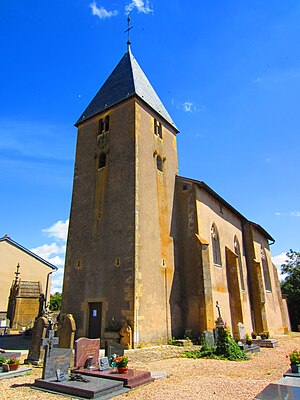Sillegny
| Sillegny | ||
|---|---|---|

|
|
|
| region | Grand Est | |
| Department | Moselle | |
| Arrondissement | Metz | |
| Canton | Faulquemont | |
| Community association | Sud Messin | |
| Coordinates | 48 ° 59 ′ N , 6 ° 10 ′ E | |
| height | 172-237 m | |
| surface | 10.46 km 2 | |
| Residents | 478 (January 1, 2017) | |
| Population density | 46 inhabitants / km 2 | |
| Post Code | 57420 | |
| INSEE code | 57652 | |
 Saint Martin Church |
||
Sillegny is a French commune with 478 inhabitants (as of January 1, 2017) in the Moselle department in the Grand Est region (until 2015 Lorraine ) in the valley of the Seille river , about 15 km south of Metz , a few kilometers east of the Moselle and not far from Pont-à-Mousson .
history
In the 11th century, Sillegny, which was then called Soleignie , belonged to the Metz Monastery of Saint-Pierre, and in the 12th century it belonged to the Bishop of Metz . In 1226 the place was known as Sulincium . Twenty years later, Bishop Jacques gave the village to the Sainte-Marie monastery as a fief, but the church remained in the possession of the diocese until the French Revolution .
In 1635, during the Thirty Years' War , Sillegny narrowly escaped destruction by the Swedes. The church developed into a well-known pilgrimage destination.
The peace of Frankfurt made the place German in 1871; In 1918, after the First World War , Sillegny returned to France. Occupied again in 1940 by Germans, the place was almost completely destroyed by bombs during the liberation in 1944. As if by a miracle, the church remained almost intact except for the tower.
1915-1918 and 1940-1944 the place had the Germanized name Sillningen .
Population development
| year | 1962 | 1968 | 1975 | 1982 | 1990 | 1999 | 2007 |
|---|---|---|---|---|---|---|---|
| Residents | 246 | 259 | 257 | 324 | 338 | 351 | 457 |
Attractions
The small Gothic fortified church of Saint-Martin with the massive tower dates from the 15th century. The interior of the church is adorned with interesting frescoes by unknown artists dating from around 1500. It was not until 1845 that the frescoes were rediscovered and restored under a uniform coat of paint. The large fresco of the Last Judgment was damaged in the bombing in 1944 and the restoration was completed in 1963.
